CMPA (cow’s milk protein allergy): understand the symptoms & what to do if you suspect a dairy allergy, plus baby milk allergy rash pictures.
CMPA (Cow’s Milk Protein Allergy): Everything You Need to Know
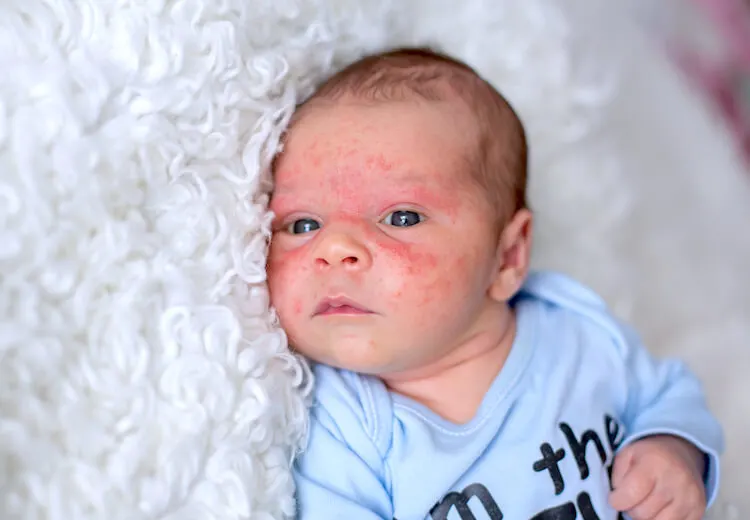
If you’re concerned about skin problems, you may wish to read my post about the differences between milk spots vs baby acne vs milk rash first.
If there are other symptoms alongside a rash, then this post will help you confirm if it’s actually the sign of a baby milk allergy.
As a mum who’s lived through breastfeeding a CMPA baby, I understand how daunting this process is.
That’s why I’ve included several baby milk allergy rash pictures to help identify what’s going on. (This post is based on my experiences and not intended as medical advice. For formal advice visit your GP.)
Is it a Baby Milk Allergy?
This article will help you identify symptoms of CMPA which may indicate cow’s milk allergy and should not be ignored.
When my youngest daughter was born (known on the blog as Elfin) she was perfect – her allergy symptoms didn’t appear until the allergen (cow’s milk protein) had made its way into her system, via my milk.
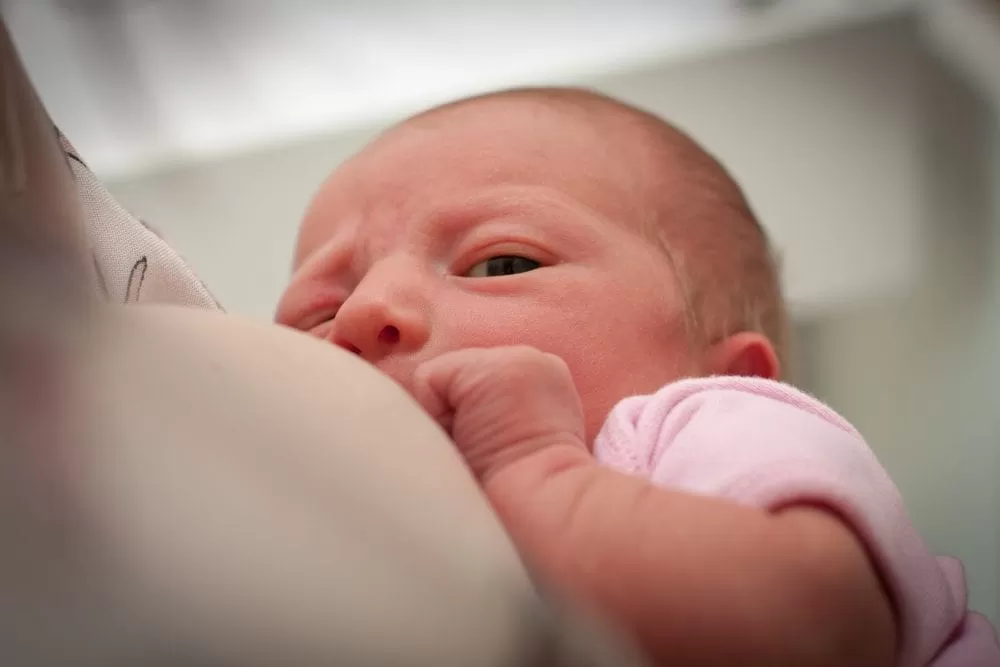
Within three short weeks her poor little face was covered in awful pustules and her skin was as terrible as a teenage boy’s. I never questioned whether it was baby acne or a more serious allergy reaction, such as CMPA, assuming the former out of ignorance.
It broke my heart.
Thankfully and by complete fluke, a consultant diagnosed Elfin soon after.
She had a classic CMPA rash, also known as cow’s milk protein allergy or dairy allergy rash (and sometimes incorrectly referred to as CMPA eczema or milk rash); I was breastfeeding and she was reacting to the dairy in my breastmilk.
It broke my heart.
What is CMPA?
CMPA is an allergy – not an intolerance – which is where the body detects a substance it thinks is a threat (in this case cow’s milk protein), triggering an abnormal response by the immune (defence) system.
N.B. If your baby is allergic to cow’s milk protein then there’s a significant possibility that they will also react to soya; studies suggest more than 10% of CMPA babies are affected.
How Do I Know if My Baby Has CMPA?
The allergy is likely to also bring other symptoms (outlined below), one of which is extreme fussiness (colic), as well as gastro issues, which may have you wondering whether your baby is suffering from silent reflux or CMPA.
The reality is that it’s not uncommon for the former to be the result of the latter.
See our Google web story for this post here.
What Does a Rash Caused By CMPA Look Like?
If you suspect your infant may be suffering from a rash caused by cows milk allergy, you’ll be curious to see examples of what it looks like.
I didn’t take many photos of my daughter at this time, but the following one is quite a good representation of the skin problems my CMPA baby endured. (Scroll down for more baby milk allergy rash pictures.)
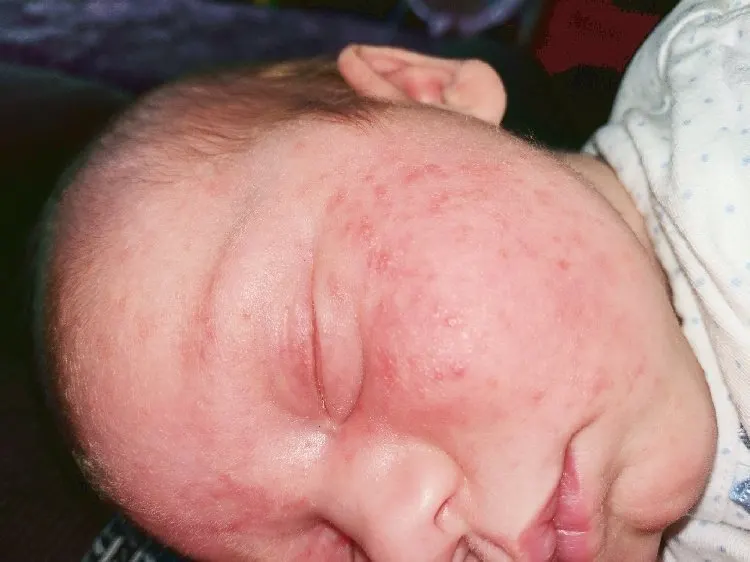
I never vocalised the extent to which it upset me that my beautiful baby’s face was blemished with hideous acne, because I was her mother and if I wasn’t going to advocate for her, then who would?
But it did bother me a great deal; partly for fear that she was suffering discomfort or even pain, and – admittedly shallow – I couldn’t bear the thought that people may consider my adorable tiny baby’s skin to be unsightly.
If you feel the same, I completely sympathise.
How Common is Milk Allergy in Babies?
CMPA occurs in around 2 – 3% of babies, but it’s far more uncommon in breastfed infants, affecting only around 0.5% through breastmilk.
A Normal Skin Complaint or CMPA Baby Rash?
If you’re reading now then chances are your baby is displaying a similar allergy rash.
So let me start off by saying that baby acne certainly does exist – my first daughter had it – but it’s not on the same scale as the angry spotty rash exhibited in CMPA babies.
To make matters more complicated, your infant may suffer from mild CMPA or more severe.
Check out my post about the differences between cow’s milk protein allergy rash and various other conditions, with a breakdown of symptoms and images to help identify what’s going on for your infant.
Does My Infant Have Cows Milk Allergy?
In my experience, the rash manifests much like acne and symptoms develop within a couple of weeks of exposure to the allergen; that is within two weeks of birth.
Unfortunately there’s no simple test to check for a cow’s milk protein allergy, meaning in the first instance it’s necessary to look at all symptoms together.
Following are images of classic rashes in CMPA babies.
If you’re curious to see examples of baby acne and other normal issues which may be confused with CMPA, read about the differences in rashes between allergies, milia, and baby acne, or see examples of what a dirty nappy from an allergy baby look like, go here.
What Does CMPA Look Like?
In my experience, the rash manifests much like acne and symptoms develop within a couple of weeks of exposure to the allergen; that is within two weeks of birth.
The rash begins as pimples, and they quickly develop into clusters, eventually covering the face, giving an angry, red appearance to the baby’s skin.
Over the course of a week or two the developing allergy rash creeps onto the ears and into the hairline, and possibly down the neck and onto the chest.
Milk Rash Pictures in Babies May Help to Identify CMPA
Often the easiest way to identify a health issue is by using visual comparisons. This is especially true when several different causes exist for a rash.
Following are some examples of pictures of milk allergy rash in babies, one of the classic symptoms of CMPA.
Baby Milk Allergy Rash Pictures and Toddler Milk Allergy Rash Pictures
Milk allergy baby rash on face:
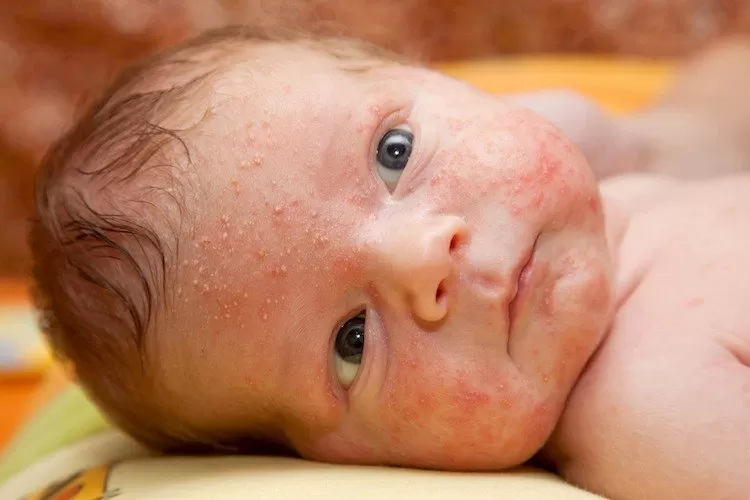

The following two images do not suggest an allergy:
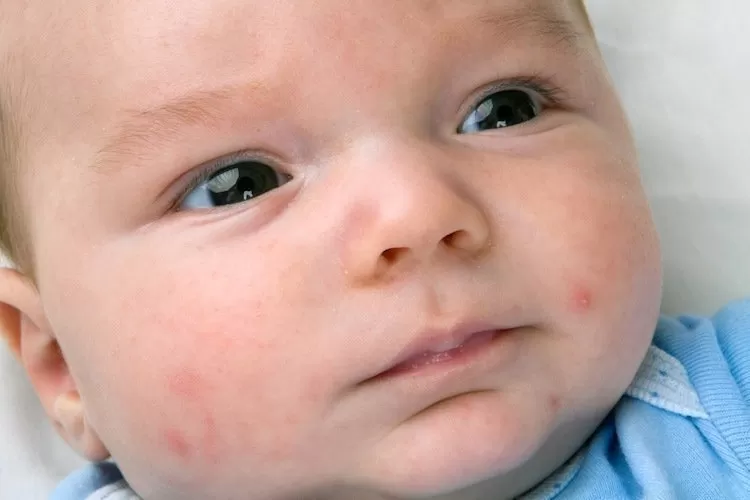
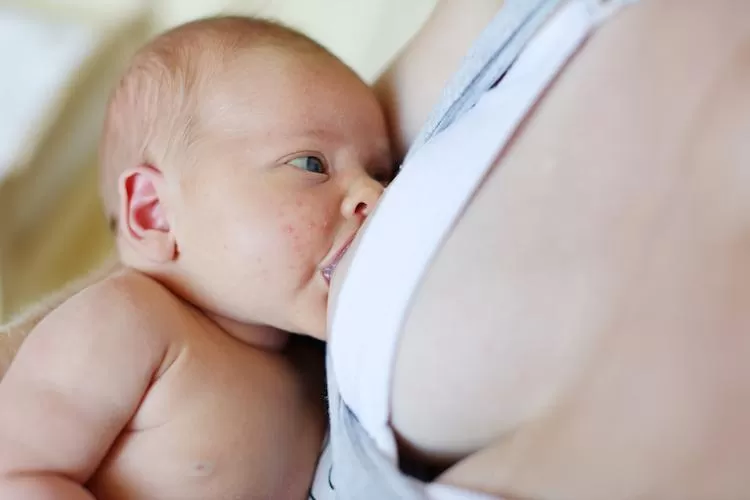

The above pictures of CMPA in babies should hopefully give you some idea of whether the symptoms your baby is exhibiting are something to be concerned about.
Note: CMPA and baby acne manifest the same whether the infant is breastfed or formula fed. Therefore, if you’re seeking allergy rash pictures for formula fed infants, the above photos may be used to help with identification.
They may also represent lactose rash images (lactose intolerance is a similar issue caused by the inability to break down the sugar in milk, as opposed to the protein).
Below I’ve also put together a checklist of all the different symptoms to be alert for and to help you determine the cause of your baby’s rash:
What Symptoms Does CMPA Cause?
CMPA and other allergies produce four sets of reactions, and depending on the type and severity, your baby may present with a combination or all of the following dermatological, gastrointestinal, respiratory, and behavioural symptoms.
Different Types of CMPA Symptoms
Listed below are typical cow’s milk allergy symptoms in babies.
Dermatological Symptoms of CMPA
- Acne
- Eczema
- Contact Dermatitis
- Rashes including hives
- Wheals
- Swelling of the eyes and/or lips, or possibly the whole face
Gastrointestinal Symptoms of CMPA
- Excessive pain
- Reflux / silent reflux
- Vomiting
- Diarrhoea
- Constipation
- Gas
- Stomach pain
- Distended stomach
- Mucousy or bloody stools
Respiratory Symptoms of CMPA
- Coughing
- Wheezing
- Persistent runny nose and/or eyes
Behavioural Symptoms of CMPA
- Unsettled
- Colicky
- Poor sleep
- Cannot be soothed when in pain
- Slow weight gain in some cases
How Serious is CMPA?
In rare and extremely severe cases anaphylaxis may occur which can be life threatening and should be treated as a medical emergency.
How Do I Know If My Baby Has CMPA?
Unfortunately, the only way to be certain is through eliminating the allergen and seeing the symptoms disappear.
The proteins take three weeks to be eliminated from your baby’s system, and if you’re breastfeeding, an additional three weeks to be eliminated from yours.
This means you’ll need to be dairy (and soya) free for six weeks to get a true indication as to whether your baby’s symptoms will improve on the elimination diet.
There are two types of food allergy, and while tests do exist, they only give a positive diagnosis for IgE allergies. Non-IgE allergies would return a false negative result, and therefore the tests are rendered unreliable.
My daughter would have tested negative, yet she responded to an elimination diet.
Confirmed Cow’s Milk Allergy Diagnosis – What Next?
Unfortunately, there’s no milk allergy treatment as such. If you suspect your baby is suffering from CMPA or another allergy, it’s important to identify the allergen/s and remove them from your baby’s diet.
To help you with this you may like to keep a food diary, especially if you suspect multiple allergens or if your baby is being cared for outside of the home.
I’ve created a diary specifically with breastfeeding mothers in mind, available exclusively to subscribers to download for free from the resources library.

How Long Does It Take a Milk Allergy Rash to Go Away?
As long as your baby remains allergic and the allergen remains present in their system, their symptoms will persist.
Can I Continue to Breastfeed My CMPA Baby?
If you’re breastfeeding, the very best thing you can do for your baby is to continue breastfeeding (this is advice I received from a paediatrician at point of diagnosis), which will mean big changes to your diet.
It’s daunting but it’s more than possible, I promise.
How Much Will Going Dairy-Free Help My Milk Allergy Rash Baby?
A lot. If CMPA is the culprit causing your baby’s symptoms, you will likely see a vast improvement very quickly after beginning an elimination diet. And when you see the difference you can make to your little one, it will feel totally worth persevering with.
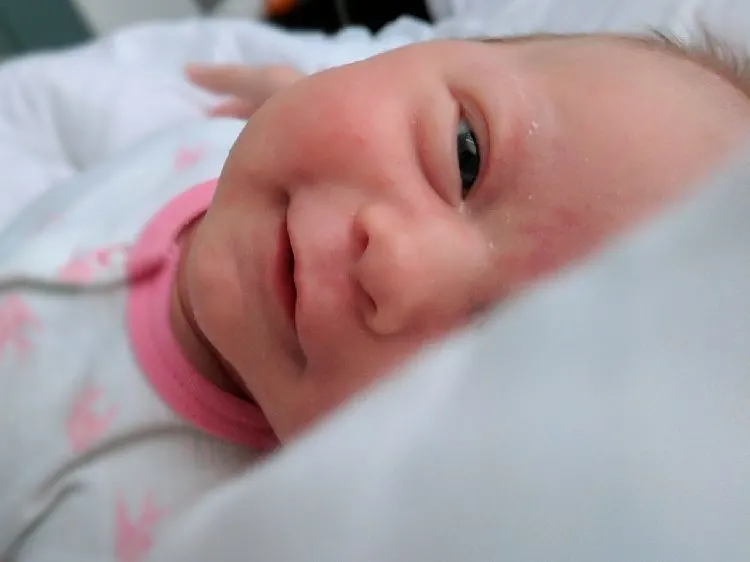
Check out my other CMPA posts for further support and guidance.
CMPA Management
Regardless of whether your baby is breast or formula fed, I highly recommend visiting your GP for support – though sadly many simply do not have up to date training.
It’s likely to be that you may struggle to find the help you need and online resources will become invaluable.
There’s also a great support group on Facebook which has been a bit of a lifeline to me. They even share a list of treats which is updated on an ongoing basis!
This essentially means that despite cutting allergen/s such as dairy and soya from your diet, you won’t have to miss out on your favourite foods – you simply need to educate yourself on where to buy the best chocolate and ice cream!
FYI, Oreos are accidentally dairy free, Ben & Jerry’s have some pretty good dairy free ice cream, and most supermarkets have quite substantial free from ranges now.
Just be mindful that many dairy free treats will contain soya, so always check the ingredients – every time, as they can change.

Confirmed CMPA – Where Do I Go From Here?
Once the rash (or other symptoms) are confirmed as being due to an allergy, you have a long road ahead of you whichever route you choose.
One thing you may wish to consider is the possibility of introducing probiotics to your baby’s diet.
Often, a CMPA infant will outgrow their allergy, but the only way to be certain is through trialling the allergens at various intervals, known as ‘challenges’ – and it’s recommended to do this with the support of a dietitian.
In the meantime, there is a lot of help available on the internet, but naturally this should not take the place of a qualified doctor’s advice.
In due course a new dimension will be added to the situation, and that’s when it comes time to wean.
This can bring increased stress, and it’s absolutely worth persisting for a referral to a consultant for diagnosis and a dietitian for assistance with managing your / your baby’s dairy free diet.
By around a year, you’ll likely be looking to attempt the milk ladder challenge, and this can be an anxious time.
Having a professional on hand to support you is likely invaluable – sadly I didn’t personally get that support so I can’t speak from experience!
In the meantime, there is a lot of help available on the internet, but naturally this should not take the place of a qualified doctor’s advice.
I hope you’ve found this introduction to allergies in babies helpful with regards to baby acne vs milk allergy, and determining whether your infant is displaying baby acne or allergy symptoms. If so, please consider sharing!

Eveline
Thursday 27th of July 2023
My baby is 5 weeks old, very restless and very little sleep. He has very spotty cheeks and also has silent reflux, he is bottle fed on aptamil! What options of baby formula is there for him that we could change to see if there’s allergies
Kate Tunstall
Friday 28th of July 2023
Hi Eveline,
Sorry to hear you're having these concerns.
Since I'm not a qualified health professional I recommend seeking advice from your GP.
Best of luck!